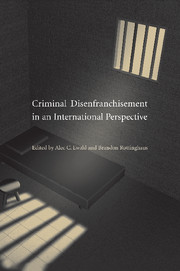Book contents
- Frontmatter
- Contents
- Contributors
- Foreword: Waves of Democracy and Criminal Disenfranchisement
- Acknowledgments
- Introduction
- Part I CONTEMPORARY DISENFRANCHISEMENT LAW
- Part II DISENFRANCHISEMENT IN COMPARATIVE PERSPECTIVE: LEGAL AND POLITICAL APPROACHES
- 3 U.S. Felon Disenfranchisement: Parting Ways with Western Europe
- 4 The Right to Universal, Equal, and Nondiscriminatory Suffrage as a Norm of Customary International Law: Protecting the Prisoner's Right to Vote
- 5 Our ‘Crooked Timber’: Why Is American Punishment So Harsh?
- Part III VOTING RIGHTS AND PEOPLE WITH CRIMINAL CONVICTIONS: CASE STUDIES
- Index
- References
3 - U.S. Felon Disenfranchisement: Parting Ways with Western Europe
Published online by Cambridge University Press: 03 July 2009
- Frontmatter
- Contents
- Contributors
- Foreword: Waves of Democracy and Criminal Disenfranchisement
- Acknowledgments
- Introduction
- Part I CONTEMPORARY DISENFRANCHISEMENT LAW
- Part II DISENFRANCHISEMENT IN COMPARATIVE PERSPECTIVE: LEGAL AND POLITICAL APPROACHES
- 3 U.S. Felon Disenfranchisement: Parting Ways with Western Europe
- 4 The Right to Universal, Equal, and Nondiscriminatory Suffrage as a Norm of Customary International Law: Protecting the Prisoner's Right to Vote
- 5 Our ‘Crooked Timber’: Why Is American Punishment So Harsh?
- Part III VOTING RIGHTS AND PEOPLE WITH CRIMINAL CONVICTIONS: CASE STUDIES
- Index
- References
Summary
In recent years, new collateral sanctions – sanctions that befall criminal offenders in addition to the punishment imposed at sentencing – have proliferated on both sides of the Atlantic. Most of them have focused on sex offenders, who are viewed as an ongoing risk to public safety and must therefore always be supervised and controlled. Those offenders are being subjected to civil confinement, registration, community notification, and an ever larger number of employment restrictions. The trend toward more collateral sanctions in Europe and the United States appears to contradict the re-enfranchisement movement, which counters another exclusion – the denial of voting rights – by allowing a larger number of convicted offenders and ex-offenders access to the ballot box. To what extent does this development presage a narrowing of the sentencing gulf between the United States and western European countries, especially Germany?
In the last decade, the United States has witnessed a public debate about felon disenfranchisement, one that intensified in the wake of the 2000 Presidential Election. Litigation and legislative attempts to change restrictive election laws have increased, with the latter meeting with some successes. Many have claimed that “these changes are emblematic of an emerging social concern with the effects of felon disenfranchisement,” which may be a function of the 2000 Presidential Election and the decreasing political saliency of crime-related issues. Nevertheless, virtually all U.S. prisoners remain disenfranchised; many probationers and those on parole are also denied the right to vote.
- Type
- Chapter
- Information
- Criminal Disenfranchisement in an International Perspective , pp. 79 - 108Publisher: Cambridge University PressPrint publication year: 2009

